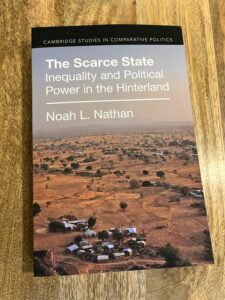This article was written by Noah Nathan for Broadstreet. The original post is available online and below we include a few excerpts below. Book: The Scarce State: Inequality and Political Power in the Hinterland.

Image: @noahlnathan.
Political scientists often measure state weakness as state absence: where we count fewer bureaucrats, where we see fewer roads that enable state penetration, or where citizens have fewer state-issued documents like IDs or birth certificates, it seems reasonable to assume states have more limited power to influence society. Zones of state absence become the “brown areas” on our maps of statehood.
Conceptualizing weakness as absence shapes how historical political economy (HPE) scholars study places with stereotypically weak states. Consider two examples from the thriving literature on precolonial and colonial legacies in Africa. Scholars often explain correlations between contemporary outcomes and precolonial institutions, such as political centralization, through arguments that presume these institutions have persisted in the face of relatively absent states incapable of fully displacing them. Along these lines, data on precolonial institutions in George Murdock’s famed Ethnographic Atlas is regularly interpreted at face-value as characterizing current ethnic group attributes. Elsewhere, studies of colonial policy often use subnational regions with less state activity as control groups for estimating effects of more extensive interventions elsewhere. The implicit assumption is that zones of state absence provide a good counterfactual for what a more undisturbed society would have looked like.
My new book, The Scarce State: Inequality and Political Power in the Hinterland, zooms in on quintessential zones of state absence: rural hinterlands. Focusing on Northern Ghana alongside shadow cases, I track the long-term effects of isolated state actions in a place that otherwise experienced limited state attention and investment since the outset of colonial rule. The book suggests that absent states can be more powerful than we often think, including through an underappreciated ability to create elements of the “strong societies” that then turn around and seem to dominate these weak states.
The book’s evidence has particular implications for HPE. I show how precolonial institutions changed massively from even fleeting contact with the modern state, suggesting a need to rethink how we understand evidence of precolonial persistence. I also explain how regions of state absence were at times changed more by state actions than areas that received much higher doses of those same policies, with hinterlands that often comprise our control groups in studies of long-run relationships far from the static reference category they are assumed to be.
[…]
Read the complete blog on Broadstreet.
Image credit: Noah Nathan.
